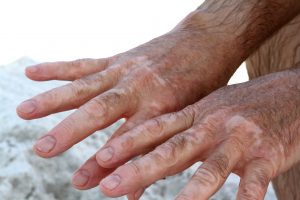
People with darker skin have more melanin, compared to those with lighter skin. To maintain its color, your skin must regularly produce melanin, so white spots on the skin are a result of melanin loss or underproduction.
Causes of white spots and patches on skin
Vitiligo: In a person with vitiligo, the melanocytes are destroyed so the melanin is not produced. At the onset, white spots will appear and then will grow into white patches. Although there is no cure, there are treatments to slow down or even halt progression of the condition.
Tinea versicolor: Fungus overgrowth on the skin can cause a fungal infection or tinea versicolor. This type of fungal infection causes changes in skin color and begins as small white spots. Normal treatment for tinea versicolor uses topical antifungal or oral medications.
Idiopathic guttate hypomelanosis: The cause of this condition is unknown, but white spots begin to appear as a result of aging, so it is common in individuals over the age of 40. Risk factors for the condition include being a female, having fair skin, having family history, and aging.
Pityriasis alba: This condition commonly affects children and adolescents. It begins with white, scaly skin on the face and can become more visible during the summer and dryer in the winter time.
Hypopigmentation: This is a condition involving the loss of color, which occurs when melanocytes get depleted or when tyrosine level decreases. Less melanin is produced, which causes white spots to appear on the skin.
Nevus depigmentosus: Unlike vitiligo, white spots resulting from this condition are permanent and stable, meaning they won’t progress and become larger. Furthermore, hair on the affected area becomes white as well.
Malnutrition: In some cases, white spots on the skin are a result of malnutrition. Having deficiencies in vitamins and minerals can result in white patches, and although harmless they should prompt you to switch to a healthier, more balanced diet.
Halo nevus: A pink or brown mole, which is surrounded by white skin – like a halo. Halo nevus is also common in vitiligo patients, and the mole should be monitored regularly to ensure it is not growing.
Lichen sclerosus: In this condition, the white patches appear in areas where the skin is thinner – genitals or anus. White spots may be localized or can grow into larger areas.
Morphea: When morphea is starting out, the skin starts becoming thicker and harder, and discoloration begins with red or purple. As it progresses, the color changes to yellow with white in the middle. Later on, patches can become brown or completely white.
Salon tanning: White spots on skin from tanning are due to the harmful UV rays. These white spots are more common in individuals taking birth control or other hormonal medications, as these affect the UV ray absorption.
Skin damage: When the skin becomes damaged – either through burns, medical conditions, or infections – white dots may appear on the skin, and many of them can be permanent. Speak to your doctor about what you can do to treat these white dots.
Eczema: Although eczema commonly looks like red rashes, it can sometimes present itself in white patches instead. It may be caused by an allergic reaction, so take note of what you are putting on your skin.
Treatment for white spots and patches on skin
Pityriasis alba: A good moisturizer, topical steroids, regular use of sunscreen, but the condition will go away on its own.
Tinea versicolor: Topical antifungal cream, oral antifungal medication, selenium shampoo.
Malnutrition: Eating foods that contain vitamins and minerals you are deficient in, or taking supplementation.
Vitiligo: Cosmetic creams, sunscreen, topical corticosteroids, immunomodulators.
Idiopathic guttate hypomelanosis: Steroid cream, cryotherapy.
Lichen sclerosis: Ointments and corticosteroids.
Home remedies for white spots and patches on skin
Aside from medical intervention to treat your white spots on skin, there are home remedies that can help lessen the appearance of the white spots.
- Radish seeds – grind the seeds into a course powder and mix with vinegar to make a paste to apply on the white patches. Leave on for 30 minutes before rinsing
- Cabbage – use cabbage extract or juice, and apply to the white patches
- Apple cider vinegar – apple cider vinegar can help destroy bacteria, so mix it with water and wash the affected area with the mixture
- Figs – consume raw figs daily
- Copper – pour water into a copper vessel and leave it overnight. Drink the copper-infused water to aid in melanin production
- Honey – honey contains antifungal properties, which can help kill fungus and bacteria on the skin
- Holy basil – apply holy basil to the affected area
- Neem – crush neem into a powder and consume daily with water
- Coconut oil – contains antifungal and antibacterial benefits so you can apply it directly to the area
There are a few other things to consider. You should try reducing stress, stop using any hard soaps when bathing, take sun bathes early for 20-30 minutes, and avoid cosmetics with triggering agents. Make sure you are eating well-balanced meals to avoid malnutrition, and reduce or cut out sodium from your diet.
Sources:
http://www.top10homeremedies.com/how-to/how-to-get-rid-of-white-patches-on-skin.html/3
http://www.disabled-world.com/artman/publish/leucoderma.shtml